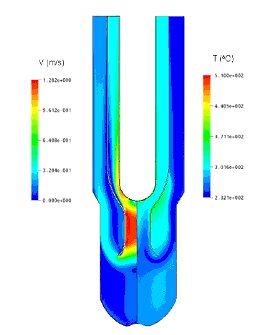Commercial CFD Codes (CFX, STAR-CD)
Main applications
- Cooling capability of the beam window of various spallation targets
- Sub-channel analysis
- Design optimisation of the active part of spallation targets
- Heat transfer analysis under specific flow conditions
- Thermal-hydraulic behavior in fuel assemblies
- Numerical studies for KALLA and other ongoing experiments
Example
Computational fluid dynamic (CFD) codes has been applied to analyze the thermal-hydraulic behavior in the active part of a spallation target. Figure 1 shows the temperature and velocity profiles in the lower part of the XADS target under steady state conditions with the maximum beam current of 6 mA. The maximum window temperature occurs in the centre of the window and is about 510oC. The maximum velocity occurs inside the funnel and is about 1.2 m/s. Both the maximum window temperature and the maximum LBE velocity are well below the design limits, which are 525°C and 2.0 m/s, respectively.

Figure 1: Temperature and velocity profile in the lower
part of the XADS target
Main references
- A. Batta, M. Daubner, X. Cheng, Investigation on turbulent mixing process in MEGAPIE target configurations, Jahrestagung Kerntechnik, May 25-27, 2004, Düsseldorf, paper 203
- A. Batta, N.I. Tak, G. Grötzbach, X. Cheng, CFD analysis of the flow behaviour in a spallation target, Jahrestagung Kerntechnik, 20-22. 05. 2003, Berlin
